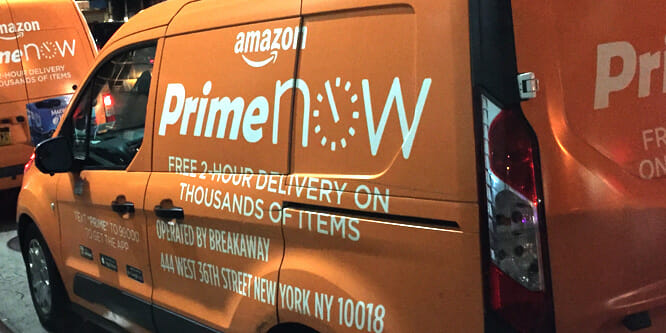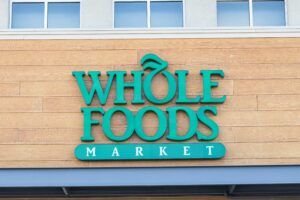
Photo: RetailWire
February 8, 2018
Amazon rolls out Prime Now deliveries from Whole Foods
It was always a matter of when, not if, Amazon.com would start offering its Prime members fast deliveries of groceries ordered from Whole Foods.
Beginning today, customers in Austin, TX, as well as in Cincinnati, Dallas and Virginia Beach, can go on Amazon to order groceries from Whole Foods via the Prime Now service and choose between one- and two-hour delivery options.
“We’re happy to bring our customers the convenience of free two-hour delivery through Prime Now and access to thousands of natural and organic groceries and locally sourced favorites,” said John Mackey, Whole Foods Market co-founder and CEO, in a statement. “Together, we have already lowered prices on many items, and this offering makes Prime customers’ lives even easier.”
While most Prime Now customers will likely opt for free delivery in two hours, those needing their orders more quickly can pay a $7.99 delivery fee to have them in an hour. Deliveries are available between 8:00 a.m. and 10:00 p.m. local time. Prices for items ordered through Prime Now may differ from those in Whole Foods’ stores.
Amazon has announced plans to expand Prime Now deliveries from Whole Foods this year without identifying what markets will be next.
Stephanie Landry, the vice president in charge of Prime Now, told The Wall Street Journal that Amazon and Whole Foods are partnering on the initiative to leverage each other’s expertise.
“You’re going to continue to see us doing lots of things together,” she told the paper.
Ms. Landry said Amazon would continue making Prime Now deliveries for Sprouts Farmers Markets and other businesses that are already part of the service.
Discussion Questions
DISCUSSION QUESTIONS: What will the addition of Whole Foods to the Prime Now program mean for Amazon and the grocery chain? How quickly do you expect Amazon and Whole Foods to roll out this option and what will it mean for competitors of the two companies?
Poll
BrainTrust
Recent Discussions








It makes sense for Amazon to offer Prime Now for Whole Foods. It’s one of Amazon’s significant advantages and, in this competitive world, any benefit is an opportunity to do more business. However, I don’t see this being the big sweep that will lure customers away from competitors. For those who shop Whole Foods and enjoy fast delivery, this will be a win. And there will be other customers who may try it especially if they need something delivered quickly, but grocery purchases are not just about speed — they’re about quality and the many customers “likes and dislikes.” Most customers become loyal to a brand or two and that often is hard to break.
The operative word is “FROM” Whole Foods locations. Rapid delivery of quality food requires local locations in order to be profitable, especially if delivery is free. This now puts Amazon on very competitive footing with local grocery store chains doing home delivery. With Amazon, the whole is always greater than sum of the parts. Prime Now is an added dimension that ties in loyalty of Prime members with discounts, not to mention the ecosystem and convenience of Alexa.
And oh, by the way, look to the U.K. for what will come. John Lewis delivers department store purchases for pickup at local Waitrose grocery locations.
This is such an important observation, especially coming on the heels of the embarrassing coverage of store-level stockouts allegedly caused by Whole Foods’ order-to-shelf system. I can’t help wondering if introducing Prime Now puts the delivery cart ahead of the store inventory horse.
Grocery delivery has been a difficult segment to monetize profitably. Primarily because of the costs of delivery and consumer hesitation.
What Amazon/Whole Foods has that no other competitor does is Amazon. What I mean by that is that Amazon/Whole Foods can leverage all of Amazons Prime’s product mix to increase the order size and lower the effective cost of delivery.
Amazon will test this concept until they refine it. This will become their home delivery food and “other product” delivery concept. When you look at the positioning of these test markets, they are markets containing an Amazon fulfillment center already delivering same-day for other Prime products.
When Amazon figures this out, competitors will not have the same logistics to replicate the model. Therefore they will be vulnerable to Amazon’s customer loyalty.
Perishable products, however, will still be one of the bigger obstacles.
As noted, no surprise here. This will contribute further to the already meteoric growth of online food shopping. While one could question Amazon’s legitimacy (I would not) of being a major food shopping alternative, the Whole Foods arrangement with Prime Now solidifies Amazon as the leader in this area.
As soon as this logistical test is moving in the anticipated direction, Amazon and Whole Foods will roll it out accordingly. For any complacent brick-and-mortar food retailers, change or die.
I hope I don’t look surprised … No big story here.
This is the expected evolution of the Whole Foods acquisition as it is the expected direction for grocery in general. The one difference here is that the service is free for Prime members which shows how Amazon will eat costs for Whole Foods — a true advantage no other supermarket can match.
As a comparison locally here in New Jersey, ShopRite and Whole Foods are located less than 1,000 feet apart. ShopRite from Home (their program) states ” … there is a fee for the selection of your order. For those stores that offer delivery, there is an additional charge.” Advantage Whole Foods, although there is (at this time) very little product or demographic overlap.
Nailed it. They’re untouchable among grocers.
This service is sure to expand the Whole Foods business, not to mention the amount of pressure it will put on competitors to both Amazon and Whole Foods. It’s a win/win but no surprise, as stated at the beginning of the article. The acquisition of Whole Foods was a calculated effort to leverage the distinct capabilities and brand of each of the companies into a synergistic group of businesses. Walmart is doing the same thing and we can look for more companies to follow suit where the opportunities exist.
Prime Now is, for the customer, prime convenience! Grocery delivery has been around for years, but when Amazon jumps into it with the Whole Foods brand, it ups the game for the industry. I always enjoy watching how Amazon rolls out ideas. They start small and, if successful, go big. Once again, Amazon continues to redefine an industry.
This was an inevitable benefit for the Amazon Prime member community. Quick delivery and mitigating the last mile is all part of the Whole Foods and Amazon value proposition. However, the biggest benefits yet to come out of this acquisition are the potential substantial changes to Wholes Foods pricing, promotion and loyalty strategies.
The bigger question remains if there will be a tiered pricing structure for both Amazon Prime and non-Prime members. Will Amazon revamp or replace the Whole Foods shopping app, which will be powered by consumer insights, enhanced by Amazon’s platform, reward loyalty and provide significant savings storewide?
This is a welcome first step and will provide convenience, however it will be interesting to see how the Whole Foods/Amazon model evolves.
The key phrase here is “prices may be different” than in the stores. Hmmm, said in the same paragraph as “we’ve lowered prices across the board in the stores” — I don’t know about you but this bugs me! It implies a lack of trust.
Thank you Anne for reading between the lines. I simply cannot deliver groceries for many reasons, and the number one reason is the need to make a profit. If Whole Foods delivers for free, you can bet it will be at regular retail, not the front page loss leaders, and that for many of us is the problem.
In my town, which is extremely poor, our customers want rock bottom prices or they will find another store at which to buy things, which is the reality of small town USA. If you add in any service like BOPIS or delivery, it will erode what small profits you might have, and no one in our town is delivering except Walmart for staples.
Whole Foods will do well with this, as they have very strong profit margins on the goods they sell and they will not give up these margins anytime soon, especially with free delivery. Advantage: again, Amazon.
This solidifies Amazon’s efforts to be the go-to source for everything in your home. Selection and pricing are important, but as an NYC resident, I’ve experienced first hand the delivery challenges in groceries, specifically perishable products. Once-melted ice cream loses something in the re-freeze. Ensuring a strong logistics infrastructure should determine the roll-out schedule or they risk damaging the brand.
This is simply an no-brainer that will help Amazon, Whole Foods and, most importantly, the customers.
This time of cheap fuel and activating omnichannel is right for establishing new delivery services by leveraging a merger/acquisition. But it is the combination of buy and build that will establish new service paradigms that exploit efficiencies against new revenues. Customer loyalty, at its associated higher margins, will be the reward.
This is going to work well for Amazon. While I believe that click and carry, not delivery, is the future of online grocery in most of the U.S., Whole Foods’ affluent customers are a clear exception.
Finally. Glad to see they are finally launching larger-scale initiatives. This should surely drive competition in local markets against the likes of PeaPod and Kroger (Through Instacart) among others. I expect an extremely aggressive rollout as they work out the kinks in the markets they are launching. With Amazon Fresh dwindling down over the past few months, this is a very real opportunity to execute on grocery the right way.
One of the main issues that remains is the “touch and feel” aspect for produce. Walmart recently applied for a patent for a solution to remedy this aspect of produce selection that many desire. I’m interested to see how they remedy this as I’m sure returns of bad produce drive decreased profitability.
Wow, this is huge — I’ll have to test it right away. If this sticks, which I imagine they’ll make it stick, I can’t wait to see the response from Kroger and the traditional players. It’s not a death knell given the difference in consumer base, but it sure sets a new bar for all grocery to deal with. No wonder there’s still only two Amazon Go pickup stores.
I don’t think this a surprise development for anyone. I think it does make us think again about the Amazon/Whole Foods relationship — and how it can be used both ways. Whole Foods gets a delivery service it couldn’t have had without Amazon (certainly not implemented as quickly), but it also highlights how Amazon now has a huge network of physical stores to play with that it didn’t have to establish from the ground up. While the focus now is on what Amazon is doing for Whole Foods, I wonder if we’ll soon be talking more about what Whole Foods is enabling Amazon to do — whether that’s strengthen its other moves in grocery, act as local pick up points, form part of its logistics set-up or even more.
While this isn’t surprising news the devil is going to be in the details:
I’m excited to see the answers to these questions. It’s a truly disruptive time in grocery.
Our recent online shopping research found Amazon was already beating supermarkets on virtually all the touch points of online shopping for food and groceries … and that was before the Whole Foods acquisition. This is a clear win for Amazon moving forward.
George said it — it was just a matter of time and we’ll likely see this rolled out into other markets in short order. Amazon will let the data drive their decision making as they understand how this service is impacting their business across the board and make the necessary adjustments. This is one of the first customer facing larger-scale initiatives bringing the two companies together and there will no doubt be many more. Separate topic: it’ll be interesting to see what this means for Instacart who just today announced another round of financing.
Amazon knows how to hook consumers (including Prime members) with incremental value-add benefits. The premium quality, variety, speed and convenience of adding Whole Foods to the online assortment will boost sales, loyalty and lifetime value per customer. Amazon is already beating Walmart at e-grocery (18 percent vs. 9 percent market share) and this move will further increase Amazon’s dominance.
Fresh products have long been the toughest nut to crack in the home delivery channel. This is a smart use of the Whole Foods fresh supply chain to solve 90 percent of the problems encountered by others. The remaining 10 percent may be unsolvable (and maybe more than 10 percent).
Product quality will not be the issue. Expectations will be the challenge. When a shopper picks from all available heads of lettuce, for example, s/he knows it is the best possible at that place and time. That won’t be the case when the box shows up at home.
It will be interesting to see how Amazon Now manages this, which I fully expect them to do. What does that mean for the competition? The same thing it has meant in the product categories in which Amazon has become the new 800 pound gorilla — increasing loss of market share.
Isn’t it about attention? Amazon is hyper-focused on where their customer’s attention is today and where it will be tomorrow. By placing their business value at the intersection of attention and expectation Amazon grows. Mobile uniquely allows this to happen quickly and efficiently. Amazon is the poster child for monetizing their customer’s attention while exceeding their expectations, thus disrupting status quo markets.
Finally, Amazon brings to life what we all expected when the acquisition was announced. Whole Foods product selection made available to Prime members in an ultra-convenient manner with 1 or 2-hour delivery. This should bring Whole Foods new customers (from Prime) as the expectation is that many Whole Foods customers were already Prime members. I expect this to roll out quickly anywhere there is good proximity to a Whole Foods location and Amazon distribution capability. This is something other grocery brands simply can’t match easily! It’s exciting to see where this takes grocery delivery in general in the US as in Europe, particularly the UK, this model has already taken hold.
The key is in the details, however, including the subtle reference to prices for some items may be different on Prime versus in-store at Whole Foods and which products are made available or not via Prime. I also agree with James Tenser’s comment about the stock replenishment issue that’s been reported at Whole Foods — will this make it worse, or is this a sign that has been resolved?
While most would agree that this current development is no surprise, Landry hints at much more collaboration between Amazon and Whole Foods.
Amazon will certainly roll out the service as aggressively as possible within the current Whole Foods footprint.
It will have an immediate effect on the adoption and repeat usage of the Prime Now program, which will boost the average customer order value of Prime Members and make them stickier.
This is a logical step for Amazon to take and become disruptive in the grocery business as they seek to develop a stronger retail presence. However, this model has inherent issues built into it. Keeping great customer service, delivering superior products, all within a very low-cost business model. Choosing the “right” vegetables and fruit that all clients like is difficult at best. Returns are guaranteed to grow. Keeping frozen food frozen, after a 2 hour delivery window in the middle of summer (ever try to keep a carton of ice cream frozen, while it sits in your car while you drive home for 2 hours?), is a difficult task, at best. Add warm deli foods, odd sized products that don’t pack well (bags of rice with cans of coke and ice cream, fresh fruit, vegetables, etc.), and you have a logistical nightmare that compromises excellent customer service and drives costs up. Good luck to Amazon to try and make this work, with this disruptive approach to the grocery business!